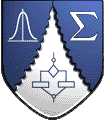 |
Maths 260 Differential Equations 2007, First Semester
Lecturer: Dr Allison Heard |
|||||
|
Course
guide
for Semester
One 2007
This paper is concerned with understanding the behaviour of solutions to ordinary differential equations. Qualitative and elementary numerical methods for obtaining information about solutions are discussed, as well as some analytical techniques for finding exact solutions in certain cases. Some applications of differential equations to scientific modelling are discussed. Preparation for the course Course web page The web page for this course is http://www.math.auckland.ac.nz/class260
Text Lecturer Dr Allison Heard (Room 414, Mathematics Building;
heard@math.auckland.ac.nz) If you want to talk to your lecturer, you can either speak to her after a lecture or go to her office. You can also make an appointment to meet at another time. Good ways to make an appointment are to speak to your lecturer after class or to send your lecturer an email message. Allison's office hours will be Monday and Friday from 2pm to 3pm, Tuesday and Friday 9am - 10am. Lectures Tutorials Use of the Undergraduate Computer Laboratory Calculators Coursework Coursework consists of assignments, a mid-semester test and tutorials. Coursework consists of assignments, mid-semester test and tutorials. Coursework is compulsory and makes up 40% of your final mark. Four assignments will be set and marked. The assignments
will be due in on the following dates: 13 March, 3 April, 8 and 22 May. Assignment marks will be
counted towards the final grade. If illness or other problems prevent you from completing any
of the
assignments please contact your lecturer as soon as possible. A medical
certificate
will be required if you wish to apply for exemption from an assignment.
If
you are ill or have other problems at the time of the test or exam you
should
contact Student Health and Counselling (extn 87681) immediately to
obtain
information on how to apply for an aegrotat or compassionate pass. Final Mark 60% final exam (2 hours) 20% mid-semester test 15% assignments 5% tutorials. Doing well in Maths 260 You should plan to spend 10 hours each week working on this
course. This includes attending lectures, reading the textbook and
doing assignment questions. Try hard not to miss lectures. If you miss a lecture, get the
lecture
notes from the web site and go over them before the next lecture. You
should
review the material from the previous lecture before coming to class.
You
can also read the recommended sections in the textbook - these are
listed
on the lecture notes handed out in the previous lecture. You can only learn mathematics by doing mathematics and it is
important to supplement lecture material by trying some of the
recommended problems from the textbook. Problems appropriate to each
lecture are listed on the lecture notes distributed in class. Answers
to these problems are given
in the back of the textbook. Try some of the problems every week. Don't
wait until it is time to study for the exam. Attempt all the assignment questions. Once your assignment is
marked, go over the assignment to check where you made mistakes. Sample
solutions to the assignments will be distributed - read them, as they
contain helpful information such as alternative ways to answer
questions. If you are having problems with material in the course, first
make sure you have read the appropriate parts of the lecture notes and
the textbook. Then speak to your lecturer, either in lectures or
tutorials or by making
an appointment with your lecturer for another time. Good ways to make
an appointment are by speaking to your lecturer after class or by
emailing your lecturer. Don't be scared to approach your
lecturers for help - they are happy to help students who are trying to
help themselves. Some help with Maths 260 may also be available in the
Mathematics Department assistance room (Room B25 in the Maths
Building), starting from the second week of semester. If you need help with computer use in the computer laboratory,
ask a demonstrator in the laboratory. Demonstrators on duty will be
wearing
a sash and there will always be a demonstrator on duty when the
Maths/Stats laboratory is open. If the demonstrators are unable to help
you with details of the Matlab package used, then ask your lecturer for
help. To prepare for the test or exam, first make sure you
understand
your lecture notes and make sure you can do all assignment and tutorial
questions. Go over some old exam papers (these can be downloaded from
the University Library webpages). The recommended problems listed in
the lecture summaries can be used for extra practice. If you have
problems, see your lecturer. 1. First order differential equations [12 lectures] (Text sections 1.1-1.8.) Introduction to differential equations and modelling with differential equations. Introduction to the software packages Matlab. Separable equations amd linear equations. Slope fields. Numerical methods (introduction only). The phase line, equilibria, and bifurcations. 2.
First order systems of differential equations [16 lectures].
(Text sections 2.1-2.5, 3.1-3.5, 3.8, 5.1, 5.2.) Phase plane and
qualitative
analysis. Linear systems, including classification of
equilibria.
Nonlinear systems, including classification of equilibria. 3.
Higher order differential equations [5 lectures]. (Text
sections 3.6, 4.1-4.3.) |
||||||
| Announcements Course guide Tutorials Assignments Old tests/exams Software guide Lecture notes Matlab software |
||||||